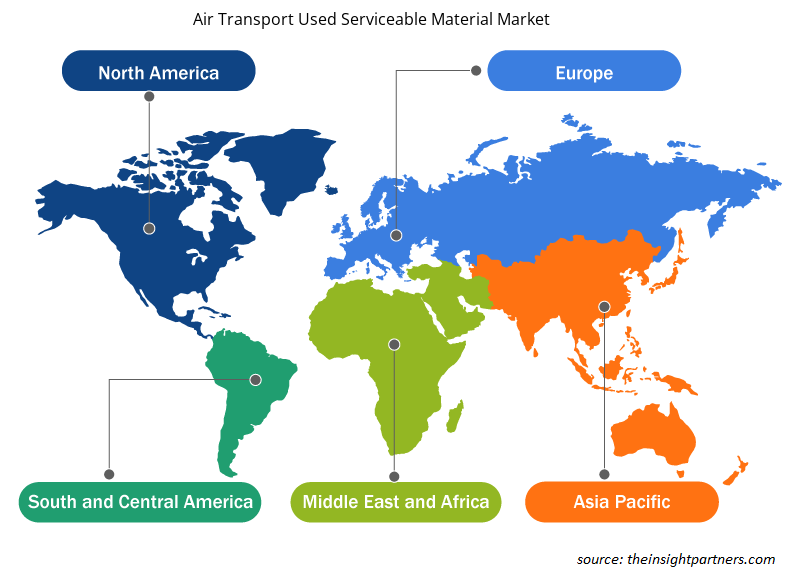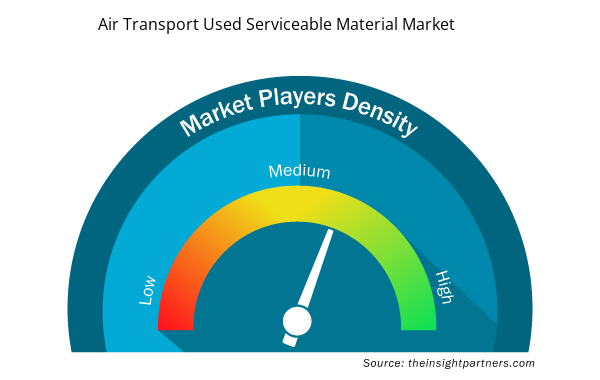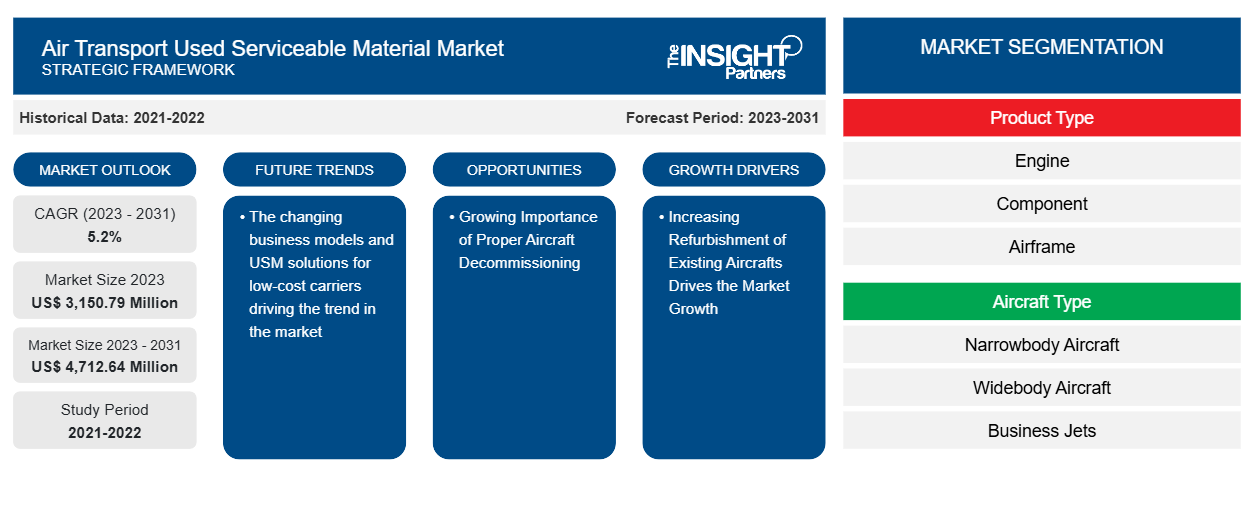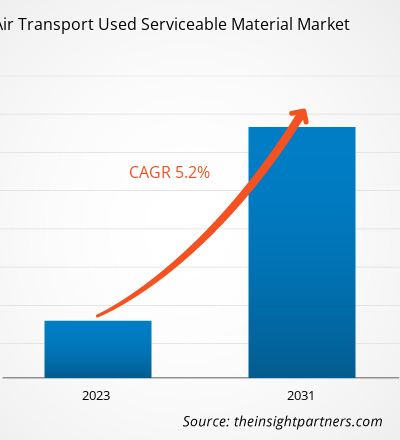航空輸送の使用済み使用可能資材の市場規模は、2023年の31億5,079万米ドルから2031年には47億1,264万米ドルに達すると予測されています。市場は2023年から2031年の間に5.2%のCAGRを記録すると予想されています。 変化するビジネスモデルと格安航空会社向けのUSMソリューションが、市場のトレンドを牽引しています。 MRO企業の業務とビジネスモデルは急速に変化しており、これは熾烈な競争や絶えず変化する世界的な動向などの要因によって推進されています。企業間の競争の激化と航空会社の艦隊の進化、航空業界への新規参入者が相まって、MRO企業の持続可能性が脅かされており、それによってプレーヤーは革新的なビジネスモデルを模索しています。
航空輸送用中古資材市場分析
航空業界では、製造技術、MRO 技術、航空機調達の傾向に関して、いくつかの重要な変化が継続的に起こっています。民間航空会社、ビジネス ジェット機の所有者、地域航空会社は、過去数年間の航空タービン燃料コストの低下から大きな恩恵を受けています。一方、エンジン メーカーは、長寿命の航空機エンジンの生産に重点を置き、それを活用しています。航空機エンジンの長寿命化により、航空エンジン業界のアフターマーケット サプライ チェーンが圧迫されています。同様に、航空タービン燃料コストの低下により、航空機所有者は既存の航空機をより長期間保持できるようになり、航空機の分解時間が短縮されます。この 2 つの要因は、使用可能な材料を使用した航空輸送の成長にプラスの影響を与えています。
航空輸送用中古資材市場の概要
航空輸送用使用可能材料 (USM) は、4 種類の航空機すべてにおいて、一部の主要な航空機部品のサービス故障時に使用されます。USM により、製品の設置までの時間が短縮され、コストも削減されます。航空輸送では使用可能材料が使用され、主にナローボディ機で使用されます。ナローボディ機は、通路の両側に 1 席しかない小型機もあり、ナローボディ ジェットの最も一般的な型は、通路の両側に 3 席ずつあります。ボーイング 737、エアバス A318/319/320/321 は、人気のナローボディ ジェット モデルの一部です。すべての大手航空機メーカーがナローボディ機の製造に携わっており、ボーイング、エアバス、ボンバルディア、エンブラエル、ツポレフなどは、世界中でナローボディ機を製造している大手航空機 OEM の一部です。この要因は、世界中でナローボディ機での USM の使用が増加している主な要因の 1 つです。
要件に合わせてレポートをカスタマイズする
このレポートの一部、国レベルの分析、Excelデータパックなど、あらゆるレポートを無料でカスタマイズできます。また、スタートアップや大学向けのお得なオファーや割引もご利用いただけます。
- このレポートの主要な市場動向を入手してください。この無料サンプルには、市場動向から見積もりや予測に至るまでのデータ分析が含まれます。
航空輸送用中古資材市場の推進要因と機会
既存航空機の改修の増加が市場の成長を促進
世界の空域では、民間航空機による航空旅行の需要が非常に高まっています。このため、航空会社や防衛軍は、最新技術で航空機を準備し、堅牢なコンポーネントが統合されるようにしています。既存の民間航空機の改修は、現在、航空業界で主流となっている大きなトレンドです。このトレンドは今後急増すると予想されており、航空機コンポーネントのサプライヤーやメンテナンス、修理、オーバーホール(MRO)企業に大きなチャンスをもたらします。航空機の改修には、エンジン、着陸装置、レーダー、アンテナなどが含まれます。USMサプライヤーは、主要な航空機コンポーネントの一部を低コストで高い信頼性で利用できるようにしており、航空機メーカーの関心が高まっています。したがって、このようなプログラムは、市場で入手可能な低コストの代替品であるため、航空輸送USMの需要を促進しています。
航空機の適切な廃止の重要性の高まり
IATA のデータによると、過去 35 年間で世界中で 15,000 機以上の商用航空機が退役しています。年間平均約 700 機の商用航空機が運用寿命を終えています。さまざまな経済的要因により、今日の航空機は早期に退役しており、航空機の平均ライフサイクルは通常 20 年から 36 年です。航空機の退役は、環境および安全上のリスクを回避するために効率的に管理する必要がある重要なプロセスになっています。
航空輸送用中古資材市場レポートのセグメンテーション分析
航空輸送の使用済み使用可能材料市場分析の導出に貢献した主要なセグメントは、製品タイプ、航空機タイプ、プロバイダー、および地理です。
- 製品タイプに基づいて、市場はエンジン、航空機部品、機体に分かれています。これらのうち、2023年にはエンジンが最大のシェアを占めます。これは、航空機部品の交換需要の増加によるものです。余剰航空機部品の需要の高まりは、航空会社のアフターマーケット戦略の再構築に大きな役割を果たしてきました。エンジン以外のパワーバイザアワーやその他の保証されたサービスレベル契約への移行により、USMの役割がより重要になり、部品の需要が増加しています。
- 航空機の種類に基づいて、市場はナローボディ機、ワイドボディ機、ビジネスジェット、リージョナルジェットに分かれています。航空機の種類の中で、ナローボディ機は運用されている航空機群の数が多いため、USM の最大のユーザーです。
- プロバイダーによって、市場はOEMと非OEMに分かれています。このうち、2023年にはOEMが最大のシェアを占めると予想されています。
航空輸送における中古資材の市場シェア分析(地域別)
航空輸送用中古資材市場レポートの地理的範囲は、主に北米、アジア太平洋、ヨーロッパ、中東およびアフリカ、南米および中米の 5 つの地域に分かれています。
北米は、いくつかの大手航空機メーカーの存在により、予測期間中に世界の航空輸送中古使用可能資材市場を支配すると予想されています。主要なキープレーヤーには、ボーイング、エアバス・ヘリコプターズ、ガルフストリーム・エアロスペース、ロッキード・マーティン、パイパー・エアクラフト、バイ・エアロスペース、シーラス、ダッソー・アビエーションなどがあります。北米の航空輸送中古使用可能資材市場は、米国、カナダ、メキシコの航空業界で発生しているさまざまなトレンドに基づいて分析されています。北米の航空部門では、機体、エンジン、航空電子機器、内装、その他のコンポーネントに関して、継続的に技術の進歩が見られます。航空旅行の需要が高まり続けるため、航空機OEMは高度な技術を備えた航空機を提供するよう継続的に求められており、MRO企業は迅速なMROサービスに対する大きな需要に直面しています。
現在の市場状況では、航空タービン燃料価格の下落が北米の航空機群と旅行の増加にプラスの影響を与えています。燃料価格の下落と航空機の納入の遅れにより、航空会社や航空機のエンドユーザーは既存の航空機群を長期間保持するようになりました。その結果、航空機の退役率は低下しています。
航空輸送用中古資材市場地域別インサイト
予測期間を通じて航空輸送用中古使用可能資材市場に影響を与える地域的な傾向と要因は、Insight Partners のアナリストによって徹底的に説明されています。このセクションでは、北米、ヨーロッパ、アジア太平洋、中東、アフリカ、南米、中米にわたる航空輸送用中古使用可能資材市場のセグメントと地理についても説明します。

- 航空輸送用中古資材市場の地域別データを入手
航空輸送用中古資材市場レポートの範囲
| レポート属性 | 詳細 |
|---|---|
| 2023年の市場規模 | 31億5,079万米ドル |
| 2031年までの市場規模 | 47億1,264万米ドル |
| 世界のCAGR(2023年~2031年) | 5.2% |
| 履歴データ | 2021-2022 |
| 予測期間 | 2023-2031 |
| 対象セグメント | 製品タイプ別
|
| 対象地域と国 | 北米
|
| 市場リーダーと主要企業プロフィール |
|
航空輸送用中古資材市場のプレーヤー密度:ビジネスダイナミクスへの影響を理解する
航空輸送用中古使用可能資材市場は、消費者の嗜好の変化、技術の進歩、製品の利点に対する認識の高まりなどの要因により、エンドユーザーの需要が高まり、急速に成長しています。需要が高まるにつれて、企業は提供を拡大し、消費者のニーズを満たすために革新し、新たなトレンドを活用し、市場の成長をさらに促進しています。
市場プレーヤー密度とは、特定の市場または業界内で活動している企業または会社の分布を指します。これは、特定の市場スペースに、その市場規模または総市場価値に対してどれだけの競合相手 (市場プレーヤー) が存在するかを示します。
航空輸送用中古資材市場で事業を展開している主要企業は次のとおりです。
- AJウォルター航空有限会社
- AAR株式会社
- AFI KLM & E&M
- デルタマテリアルサービス
- GAテレシス
- 有限責任会社
免責事項:上記の企業は、特定の順序でランク付けされていません。

- 航空輸送用中古資材市場のトップキープレーヤーの概要を入手
航空輸送用中古資材市場のニュースと最近の動向
航空輸送用中古使用可能資材市場は、重要な企業出版物、協会データ、データベースを含む一次および二次調査後の定性的および定量的データを収集することによって評価されます。航空輸送用中古使用可能資材市場の動向のいくつかを以下に示します。
- Block Aero と航空機フリートリサイクル協会 (AFRA) は、シリアル番号付き部品の「Registry-as-a-Service」耐空性コンプライアンス ソリューションの開始を発表します。この取り組みにより、航空機部品管理の安全性、効率性、追跡可能性が向上します。この戦略的パートナーシップでは、Block Aero の最先端の航空ブロックチェーン プラットフォームを活用して、最先端のデータベース ソリューションを実装します。このレジストリは、航空アフターマーケットで再利用される航空機部品の情報管理と公開に関する民間航空当局の要件を満たすように設計されています。(出典: 企業 Web サイト、2024 年 3 月)
航空輸送用中古資材市場レポートの対象範囲と成果物
「航空輸送用中古資材市場規模と予測(2021~2031年)」レポートでは、以下の分野をカバーする市場の詳細な分析を提供しています。
- 航空輸送用使用済み資材の市場規模と予測は、対象範囲に含まれるすべての主要市場セグメントについて、世界、地域、国レベルで示されています。
- 航空輸送では、有用な材料の市場動向だけでなく、推進要因、制約、主要な機会などの市場動向も使用されます。
- 詳細なPESTおよびSWOT分析
- 航空輸送用中古資材市場分析では、主要な市場動向、世界および地域の枠組み、主要プレーヤー、規制、最近の市場動向を取り上げています。
- 航空輸送用中古資材市場における市場集中度、ヒートマップ分析、主要プレーヤー、最近の動向を網羅した業界展望と競争分析。
- 詳細な企業プロフィール
- 過去2年間の分析、基準年、CAGRによる予測(7年間)
- PEST分析とSWOT分析
- 市場規模価値/数量 - 世界、地域、国
- 業界と競争環境
- Excel データセット


- Single Pair Ethernet Market
- Cut Flowers Market
- Small Satellite Market
- Helicopters Market
- Biopharmaceutical Contract Manufacturing Market
- Military Rubber Tracks Market
- Small Internal Combustion Engine Market
- Airport Runway FOD Detection Systems Market
- Visualization and 3D Rendering Software Market
- Predictive Maintenance Market

Report Coverage
Revenue forecast, Company Analysis, Industry landscape, Growth factors, and Trends

Segment Covered
This text is related
to segments covered.

Regional Scope
North America, Europe, Asia Pacific, Middle East & Africa, South & Central America

Country Scope
This text is related
to country scope.
よくある質問
The market is expected to register a CAGR of 5.2% during 2023–2031.
The air transport used serviceable material market size is projected to reach US$ 4,712.64 million by 2031 from US$ 3,150.79 million in 2023.
The changing business models and USM solutions for low-cost carriers are driving the trend in the market.
A J Walter Aviation Limited, AAR Corp, AFI KLM & E&M, Delta Material Services, GA Telesis, LLC, General Electric, Liebherr Group, Lufthansa Technik, Pratt & Whitney, and Honeywell International Inc., and others.
Increasing Refurbishment of Existing Aircrafts Drives Market Growth.
North America is expected to dominate the air transport used serviceable material market in 2023.
Trends and growth analysis reports related to Aerospace and Defense : READ MORE..
The Insight Partners performs research in 4 major stages: Data Collection & Secondary Research, Primary Research, Data Analysis and Data Triangulation & Final Review.
- Data Collection and Secondary Research:
As a market research and consulting firm operating from a decade, we have published and advised several client across the globe. First step for any study will start with an assessment of currently available data and insights from existing reports. Further, historical and current market information is collected from Investor Presentations, Annual Reports, SEC Filings, etc., and other information related to company’s performance and market positioning are gathered from Paid Databases (Factiva, Hoovers, and Reuters) and various other publications available in public domain.
Several associations trade associates, technical forums, institutes, societies and organization are accessed to gain technical as well as market related insights through their publications such as research papers, blogs and press releases related to the studies are referred to get cues about the market. Further, white papers, journals, magazines, and other news articles published in last 3 years are scrutinized and analyzed to understand the current market trends.
- Primary Research:
The primarily interview analysis comprise of data obtained from industry participants interview and answers to survey questions gathered by in-house primary team.
For primary research, interviews are conducted with industry experts/CEOs/Marketing Managers/VPs/Subject Matter Experts from both demand and supply side to get a 360-degree view of the market. The primary team conducts several interviews based on the complexity of the markets to understand the various market trends and dynamics which makes research more credible and precise.
A typical research interview fulfils the following functions:
- Provides first-hand information on the market size, market trends, growth trends, competitive landscape, and outlook
- Validates and strengthens in-house secondary research findings
- Develops the analysis team’s expertise and market understanding
Primary research involves email interactions and telephone interviews for each market, category, segment, and sub-segment across geographies. The participants who typically take part in such a process include, but are not limited to:
- Industry participants: VPs, business development managers, market intelligence managers and national sales managers
- Outside experts: Valuation experts, research analysts and key opinion leaders specializing in the electronics and semiconductor industry.
Below is the breakup of our primary respondents by company, designation, and region:

Once we receive the confirmation from primary research sources or primary respondents, we finalize the base year market estimation and forecast the data as per the macroeconomic and microeconomic factors assessed during data collection.
- Data Analysis:
Once data is validated through both secondary as well as primary respondents, we finalize the market estimations by hypothesis formulation and factor analysis at regional and country level.
- Macro-Economic Factor Analysis:
We analyse macroeconomic indicators such the gross domestic product (GDP), increase in the demand for goods and services across industries, technological advancement, regional economic growth, governmental policies, the influence of COVID-19, PEST analysis, and other aspects. This analysis aids in setting benchmarks for various nations/regions and approximating market splits. Additionally, the general trend of the aforementioned components aid in determining the market's development possibilities.
- Country Level Data:
Various factors that are especially aligned to the country are taken into account to determine the market size for a certain area and country, including the presence of vendors, such as headquarters and offices, the country's GDP, demand patterns, and industry growth. To comprehend the market dynamics for the nation, a number of growth variables, inhibitors, application areas, and current market trends are researched. The aforementioned elements aid in determining the country's overall market's growth potential.
- Company Profile:
The “Table of Contents” is formulated by listing and analyzing more than 25 - 30 companies operating in the market ecosystem across geographies. However, we profile only 10 companies as a standard practice in our syndicate reports. These 10 companies comprise leading, emerging, and regional players. Nonetheless, our analysis is not restricted to the 10 listed companies, we also analyze other companies present in the market to develop a holistic view and understand the prevailing trends. The “Company Profiles” section in the report covers key facts, business description, products & services, financial information, SWOT analysis, and key developments. The financial information presented is extracted from the annual reports and official documents of the publicly listed companies. Upon collecting the information for the sections of respective companies, we verify them via various primary sources and then compile the data in respective company profiles. The company level information helps us in deriving the base number as well as in forecasting the market size.
- Developing Base Number:
Aggregation of sales statistics (2020-2022) and macro-economic factor, and other secondary and primary research insights are utilized to arrive at base number and related market shares for 2022. The data gaps are identified in this step and relevant market data is analyzed, collected from paid primary interviews or databases. On finalizing the base year market size, forecasts are developed on the basis of macro-economic, industry and market growth factors and company level analysis.
- Data Triangulation and Final Review:
The market findings and base year market size calculations are validated from supply as well as demand side. Demand side validations are based on macro-economic factor analysis and benchmarks for respective regions and countries. In case of supply side validations, revenues of major companies are estimated (in case not available) based on industry benchmark, approximate number of employees, product portfolio, and primary interviews revenues are gathered. Further revenue from target product/service segment is assessed to avoid overshooting of market statistics. In case of heavy deviations between supply and demand side values, all thes steps are repeated to achieve synchronization.
We follow an iterative model, wherein we share our research findings with Subject Matter Experts (SME’s) and Key Opinion Leaders (KOLs) until consensus view of the market is not formulated – this model negates any drastic deviation in the opinions of experts. Only validated and universally acceptable research findings are quoted in our reports.
We have important check points that we use to validate our research findings – which we call – data triangulation, where we validate the information, we generate from secondary sources with primary interviews and then we re-validate with our internal data bases and Subject matter experts. This comprehensive model enables us to deliver high quality, reliable data in shortest possible time.


 このレポートの無料サンプルを入手する
このレポートの無料サンプルを入手する